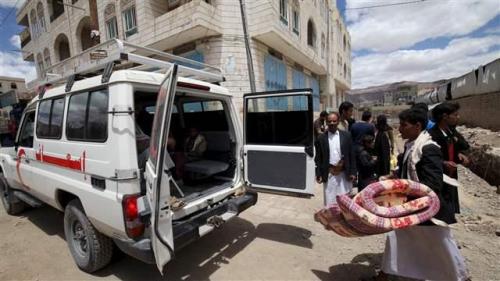According to the United Nations, Yemen is the world’s worst humanitarian crisis. Approximately 80 percent of the population—24.1 million people—require humanitarian assistance, with half on the brink of starvation. Since March 2015, some 3.65 million have been internally displaced—80 percent of them for over a year. By 2019, it was estimated that fighting had claimed over 100,000 lives, with another 131,000 dying from hunger, disease, and lack of medical care—a combined death toll equivalent to nearly 1 percent of the population. Poverty increased from 47 percent of the population in 2014 to 75 percent in 2019.
A UNDP-commissioned report calls Yemen’s war “one of the highest-impact internal conflicts since the Cold War. On par with Iraq, Sierra Leone, Liberia, and the Democratic Republic of Congo—conflicts with an impact on development that lasts for a generation.” If the war ends in 2021, development gains in Yemen will have already been set back a quarter-century; the country will also be the poorest in the world with 79 percent of the population living below the poverty line and 65 percent classified as extremely poor. If the war continues until 2030, the reversal will be 40 years—erasing a generation-and-a-half of gains.
The war continues to exact a toll
Despite talks between the Houthis and the Saudi-led coalition initiated last October, fighting has resumed. Houthi missiles once again target Saudi Arabia, while Saudi airstrikes hit the Houthi-controlled capital, Sana’a. The war within a war, which pitted the internationally recognized and Saudi-supported Hadi government against the United Arab Emirates and the Southern Transitional Council, abated after the 2019 Riyadh agreement. But given ongoing sharp tensions, how long that will last is unclear
While the complete humanitarian costs of the Saudi-led blockade have yet to be calculated, Saudi-led coalition airstrikes have killed thousands and targeted over a hundred medical facilities. Among these was a well-marked and preidentified cholera treatment center established by Doctors Without Borders for the country’s nearly 1 million suspected cholera cases. Houthis may also have killed hundreds through indiscriminate shelling, targeting civilians with snipers, and siege warfare. According to the U.N., all combatants are “committing horrific abuses from arbitrary killings to rape and torture with impunity that underscores a collective failure of the international community.”
Profiteering is endemic
All sides also practice economic warfare, using obstruction and financial tools to deny resources to opponents. With powerful forces benefiting materially from the war, there is little hesitation in impeding peace efforts.
The U.N. accuses the Hadi government of significant diversion of funds, including revenues from sales of natural gas and customs taxes in various ports and crossing points. Illicit profits are also made from manipulation of foreign exchange rates and policies giving preference to crony businesses. In the oil sector, for example, businessman Ahmed Saleh al-Eisei—an adviser to the president and close associate of his son—is accused of manipulating oil prices while controlling monopolies in transport and other areas. That these allegations surface consistently in U.N. reports underlines their deep-seated nature.
The Houthis too manipulate imported oil prices while expropriating assets owned by opponents, including former ally President Saleh who was killed when he opposed the Houthis. The U.N. documents the transfer of public funds to field commanders through the creation of false supply contracts and extorting money by arresting company managers and bank directors, threatening to accuse them of treason and espionage.
Humanitarian aid is squandered
Another tempting target is the world’s largest aid program. The Houthis control most of the Yemeni population, and therefore most humanitarian aid—roughly $3.7 billion in 2019—is targeted to Houthi areas. By February 2020, Houthi rebels had blocked half this aid—a tactic to control aid resources as tons of food rotted without being distributed. In early 2018, they established the Supreme Council for Management and Coordination of Humanitarian Affairs and International Cooperation (SCMCHA) demanding a 2 percent tax on humanitarian aid. Donors balked but harassment and aid diversions continue. In the meantime, the SCMCHA is embroiled in scandals, including its top three officials being paid separately by three different U.N. agencies, suspect contracts, and other questionable activities.
The U.N. has revamped procedures, but millions have been squandered. The U.N., with thousands of dedicated staff on the ground, has also faced financial scandals as the World Health Organization grappled with funds diverted to personal accounts, the hiring of unqualified people, and numerous questionable contracts. UNICEF was also investigated for allowing a Houthi leader to travel in agency vehicles, shielded from airstrikes.
Resolution remains elusive
The agony of the Yemeni people, with predators from within and without, is hard to overstate. This was not a war of necessity for the Saudis, the UAE, or Iran. Nor was the West—lucrative arms sales aside—deeply committed with significant strategic interests at play. It was largely a sideshow for all except the Yemeni people. Now, after years of war, a resolution remains elusive as the Hadi government, the Southern Transitional Council, and the Houthis will have to reconcile their interests managing internal divisions and the demands of their Saudi, UAE, and Iranian patrons. In a move that will worsen the humanitarian tragedy, the U.S. scaled back vital aid on March 27 to Houthi controlled areas citing continuing diversion and harassments. The move and its timing were opposed by international aid officials and some Democratic lawmakers who cited Yemen’s looming COVID-19 crisis. While the coronavirus has yet to be documented in Yemen and a very shaky pandemic driven ceasefire has taken hold, the WHO predicts “a perfect storm of a disaster should this virus introduce itself.” Amid all this, Yemeni civilians face a downward spiral with little hope and utter desperation. They deserve better.







Commentary
Yemen’s civilians: Besieged on all sides
March 31, 2020